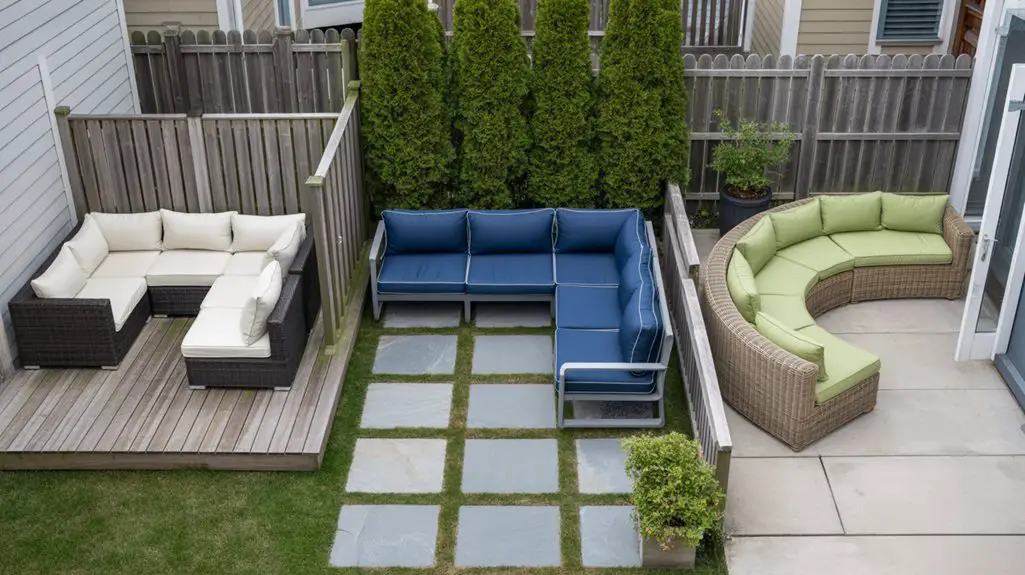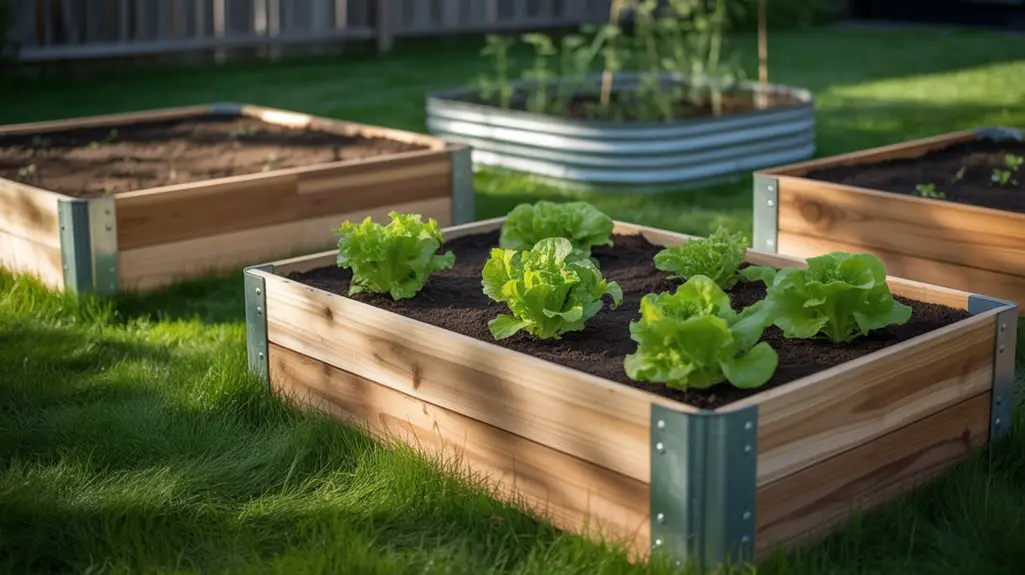When you’re planning your garden’s circulation system, the materials you choose impact both aesthetics and environmental footprint. Traditional concrete and asphalt options seal the earth, preventing natural water absorption and creating unnecessary runoff. Instead, consider sustainable alternatives that complement your landscape while supporting ecological functions. These eco-friendly path materials offer durability and visual appeal without compromising environmental values—and they often outperform conventional options in longevity and maintenance requirements.
Recycled Wood Chip Pathways: Natural Appeal With Sustainability
Recycled wood chips represent one of the most accessible and eco-conscious materials for garden path construction. You’ll find these byproducts of arboriculture and lumber processing readily available from tree services, municipal waste centers, and landscape suppliers—often at minimal or no cost.
When installing, aim for a 2-3 inch depth to effectively suppress weeds while allowing proper decomposition. Select hardwood varieties for longevity; they break down more slowly than softwoods, extending your path’s functional lifespan to 1-2 years before requiring replenishment.
For ideal drainage and stability, install a permeable landscape fabric beneath the chips. This prevents material from sinking into soil while allowing rainfall infiltration—supporting groundwater recharge.
The material’s natural texture also provides excellent traction in wet conditions, enhancing safety while complementing surrounding vegetation with its organic aesthetic. Additionally, using recycled materials in garden paths not only promotes sustainability but also reduces landfill waste.
Permeable Gravel Designs for Water Conservation

Permeable gravel systems offer a step up in durability from wood chips while maintaining excellent water conservation properties. These designs utilize angular gravel with varying particle sizes (typically 3/8″ to 3/4″) laid over a base of crushed stone and geotextile fabric. The irregular shapes create pockets that allow rainwater to percolate through rather than run off.
You’ll find several environmental benefits in these installations. First, they reduce stormwater runoff by up to 80% compared to concrete, replenishing groundwater supplies naturally.
Second, the filtration process removes pollutants as water moves through the layers. For ideal performance, use locally-sourced gravel to minimize transportation emissions, and install with a slight crown (1-2% grade) to prevent pudding. Incorporating sustainable landscaping ideas can further enhance the eco-friendliness of your outdoor space.
Maintenance is minimal—simply rake occasionally and top-up gravel every 3-5 years as needed.
Reclaimed Brick and Stone Pathway Solutions

When sourced from demolition sites or architectural salvage yards, reclaimed brick and stone offer exceptional durability while considerably reducing environmental impact compared to new materials.
These elements bring patina and character impossible to replicate with manufactured products.
For installation, create a 4-6″ compacted gravel base topped with 1″ of bedding sand.
Position your reclaimed materials in your desired pattern—herringbone for bricks or irregular mosaics for stone pieces.
Fill joints with fine sand or plant low-growing groundcover like corsican mint between gaps for added permeability.
Mix materials strategically—combine weathered red brick with slate or limestone pieces for visual interest.
You’ll find these combinations naturally manage water runoff better than concrete alternatives, while their thermal mass regulates soil temperature and reduces garden microclimates. Additionally, eco-friendly materials play a crucial role in creating sustainable garden designs that benefit both your landscape and the environment.
Living Ground Cover Paths: Beyond Traditional Materials
Living ground cover paths represent a radical departure from hardscaping traditions, offering a soft, resilient alternative that blends seamlessly with surrounding garden ecosystems.
You’ll find several low-growing species ideal for foot traffic, including creeping thyme, corsican mint, and dwarf mondo grass.
These living pathways provide ecological benefits beyond aesthetics—they absorb rainfall, reduce runoff, and create microhabitats for beneficial insects.
Unlike traditional materials, they actively sequester carbon and require no manufacturing energy.
When installing, you’ll need to prepare well-draining soil and arrange stepping stones strategically for heavier traffic areas.
Select species based on your climate zone and sun exposure.
Most ground covers need regular trimming at boundaries to prevent garden encroachment, but they’ll reward you with sensory elements—fragrance, texture, and seasonal color changes—that hardscaping simply can’t deliver. Additionally, incorporating native plants can enhance biodiversity and attract pollinators to your garden.
Bamboo and Cork Pathway Innovations
While living ground covers offer a completely organic pathway solution, bamboo and cork present sustainable alternatives that combine structure with eco-consciousness.
These rapidly renewable materials deliver durability while maintaining a low environmental footprint.
- Bamboo slats can be installed horizontally or vertically, creating aesthetically pleasing pathways that drain efficiently and resist rot for 7-10 years.
- Carbonized bamboo offers enhanced weather resistance through a non-toxic heating process that removes sugars and starches.
- Cork pathway tiles utilize wine industry byproducts, providing excellent shock absorption and natural antimicrobial properties.
- Both materials offer end-of-life compostability, unlike concrete or plastic composites.
These alternatives align with the eco-friendly options for garden pathways in creating beautiful spaces that are kind to the environment.
You’ll find these materials particularly suitable for connecting garden zones where you need more structure than living ground covers but wish to avoid petroleum-based or energy-intensive alternatives.
Recycled Rubber and Glass Aggregate Options
For gardeners seeking alternatives that divert waste from landfills, recycled rubber and glass aggregates represent innovative pathway solutions with distinctive environmental benefits. These materials transform consumer waste into functional, aesthetic garden elements while reducing environmental impact.
| Material | Benefits | Durability | Installation |
|---|---|---|---|
| Rubber Mulch | Slip-resistant, cushioned | 10-12 years | Low maintenance |
| Rubber Pavers | Shock-absorbing, weatherproof | 15+ years | Interlocking systems |
| Tumbled Glass | Light-reflective, drainage-enhancing | Lifetime | Requires edging |
| Glass Aggregate | Custom colors, non-porous | Permanent | Mix with binding agent |
You’ll find these options particularly effective in high-traffic areas. Rubber products typically come from recycled tires, while glass aggregates derive from post-consumer bottles and industrial waste, offering a responsible solution for sustainable landscaping projects.
Natural Clay and Decomposed Granite Path Systems
Among traditional pathway materials, natural clay and decomposed granite stand out as highly sustainable options that seamlessly integrate with garden ecosystems.
Both materials offer excellent permeability, allowing rainwater to filter naturally into the soil rather than contributing to runoff issues.
When installing these systems, you’ll need to take into account:
- Depth requirements: 3-4 inches for decomposed granite and 2-3 inches for natural clay
- Compaction techniques: hand tamping for small areas, plate compactor for larger installations
- Edge restraints: essential for maintaining path integrity over seasons
- Maintenance cycles: annual top-dressing for granite paths; clay paths may need occasional refilling
These materials weather beautifully with age, developing character while remaining functional. Additionally, unique stone walkway designs can enhance the aesthetic appeal of your garden paths.
Their earthy tones complement most landscape designs, and they’re considerably less resource-intensive than concrete or asphalt alternatives.
Conclusion
Your garden path choices can radically transform your outdoor space’s sustainability profile. By selecting permeable, recycled, and living materials, you’re creating systems that’ll work with nature, not against it. These options don’t just send water runoff “down the information superhighway” to proper drainage—they’re technically superior alternatives that reduce environmental impact while maintaining structural integrity. You’re making an investment in both aesthetics and ecological function with every sustainable step.




